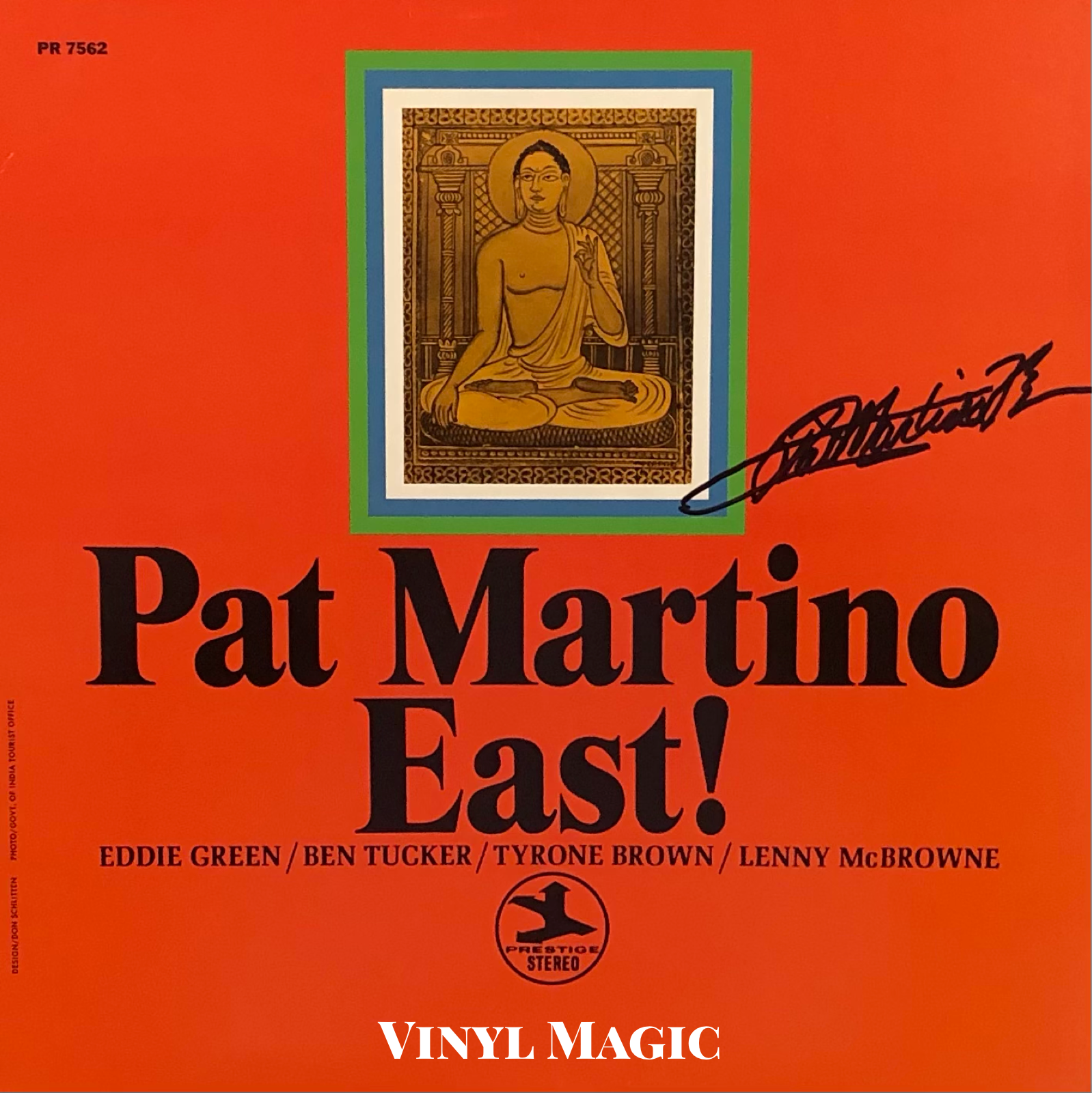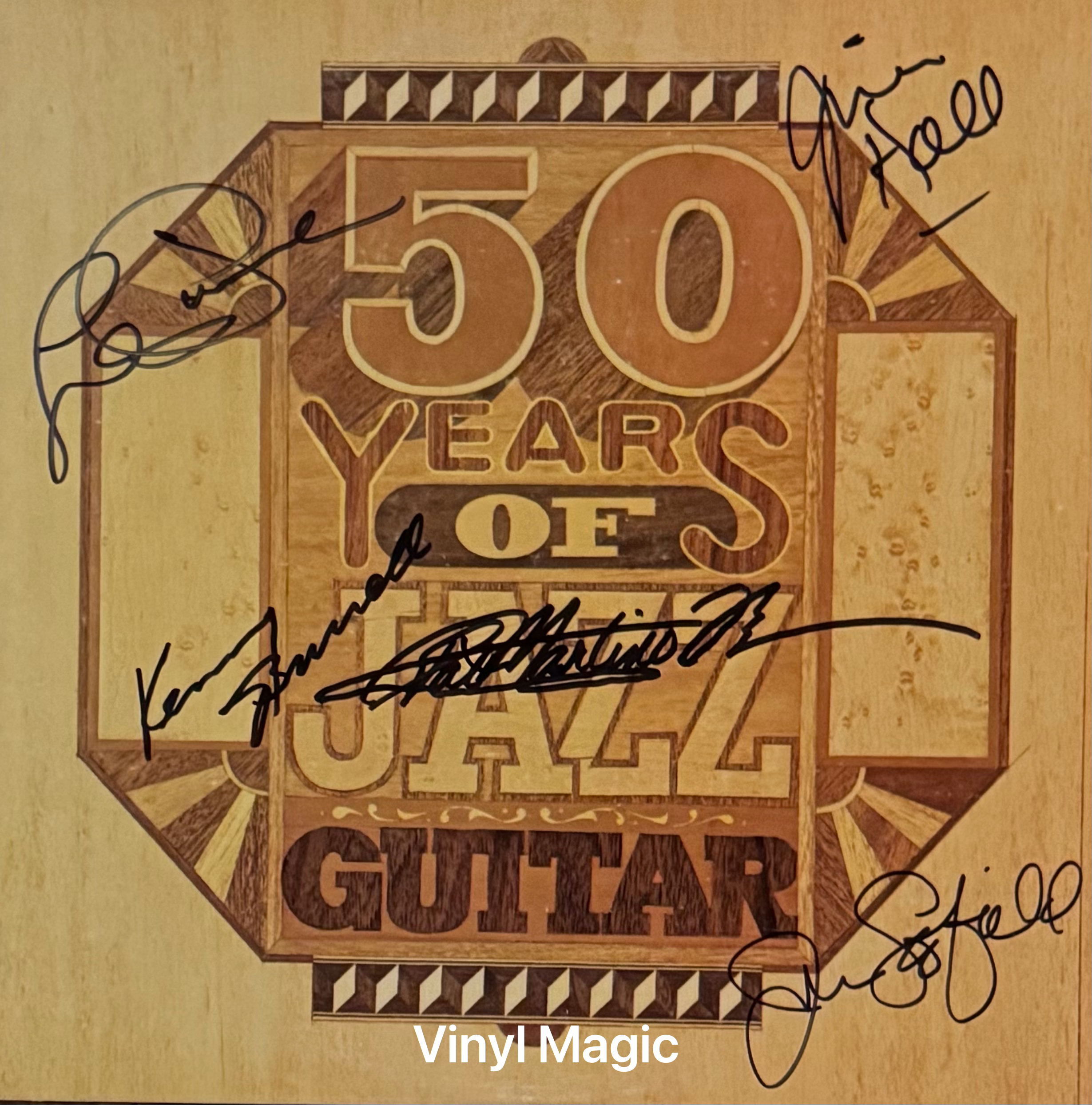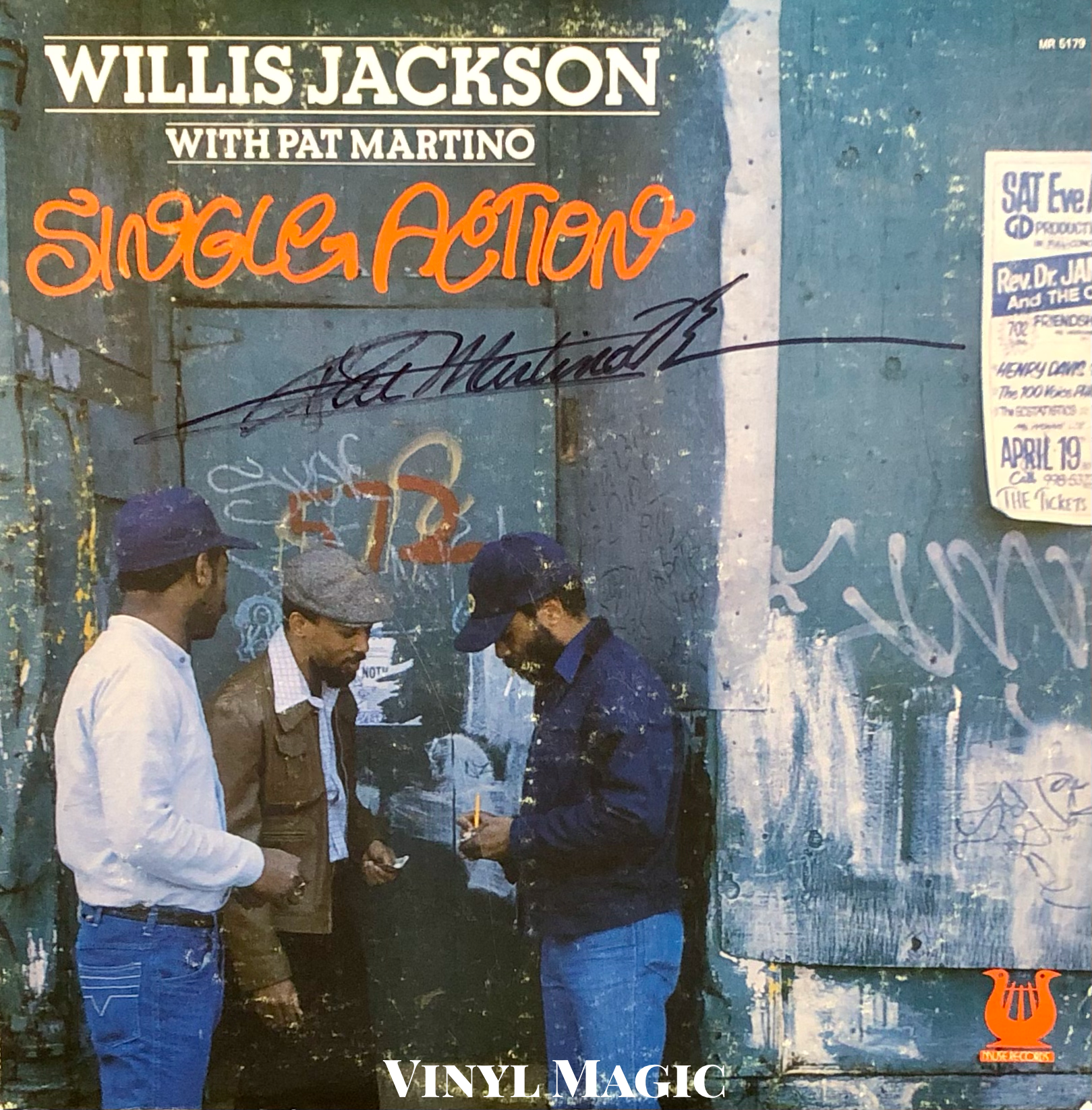Pat Martino and Me...
Jazz is a way of life, not an idiom of music. Jazz is spontaneous improvisation. If you ever walk out of your house with nowhere to go, just walking for the pleasure of it and observing what’s around you, you’ll find that you improvise. Everyone in life improvises; jazz is just relative degrees of improvisation.
Pat Martino
East! (1968) signed by Pat
I was flabbergasted, man! Martino stayed on my mind because I knew there was another standard out there that all guitar players had to recognize, and he was setting it. He showed us that there was much more to the guitar than we were hearing.
George Bernson seeing Pat in the early 1960s in Harlem
Bahia: The Clear Evidence
The organ trio format is, and always was, a unique experience. There’s something about it that makes it a different instrument in itself. Unlike a normal rhythm section with keyboard, bass and drums, the use of organ unifies two separate functions into one identity, and there’s a strength in that that’s unlike any other instrumentation. As far as drawbacks, there are none, as long as that particular format isn’t compared to another.
Pat Martino
A Change Is Gonna Come (1966) signed by Pat, Jack McDuff, George Coleman, Bernard “Pretty” Purdie
The guitar is of no great importance to me, the people it brings to me are what matter. They are what I'm extremely grateful for, because they are alive. The guitar is just an apparatus.
Pat Martino
Walk On By (1966) signed by Pat, Jack McDuff, Benny Golson, Red Holloway
Pat Martino, a revered jazz guitarist, declared in a recent interview, "A jazz musician doesn't retire." And he would know, he has overcome health setbacks and tragedies in his lengthy career while still performing at peak level, the embodiment of perseverance, persistence and recovery. Born Pat Azzara in Philadelphia, he grew up surrounded by music. His father was a saloon singer (stage name = Mickey Martino) who encouraged Pat to play guitar. A seminal influence was the recording of Johnny Smith's "Moonlight In Vermont." Pat remembered, "When I was ten years old, I copied all of Johnny Smith’s solos and I experienced a drastic confrontation because of that. My father used to take me around to different nightclubs almost like a protege and when the time came for me to take a solo, I would take a Johnny Smith solo. The only problem with that is that the ensemble that I was sitting in with didn’t play it in the same key. That forced me to be a little more realistic and I had to get involved. First of all, I had to learn to transpose and a number of other things. I think it was an essential series of metamorphoses that took place because of it. But when you come down to the source and reason for Johnny Smith coming into my life, that was mainly my father."
Strings!
Under his father's watchful tutelage, Pat's talents blossomed and he quit school to go on tour: "When I first went on the road at age fifteen with guys like Willis Jackson, Red Holloway and Sleepy Henderson, I wasn't concerned about being creative. It was just a job to me, and I was infatuated by the traveling. What really made me realize this attitude would not fulfill me was a four month period I spent working with Sonny Stitt. Sonny is such an inspiration and every night on the stand was a challenge. Suddenly, I knew I had to meet that challenge."
Bar Wars
He met that challenge and so many more. In those days, Philadelphia was a thriving jazz nexus with home grown stars like John Coltrane, Benny Golson, the Heath Brothers, Lee Morgan and McCoy Tyner, not to mention the Hammond B3 jazz greats Jimmy Smith, Charles Earland, Richard "Groove" Holmes and Jimmy McGriff. Asked about these legends and all the jazz activity, Pat noted recently, " I don’t know what to say about that other than the fact that Philadelphia is so close to New York City. There is a professional core of activity in the industry. Philadelphia is a suburb of New York City. It is merely 90 miles away." Notwithstanding the shrieks and protests of aggrieved Philadelphians, and especially their rabid sports fans, Pat does have a point. In the jazz world, we are all just a suburb of New York City!
The Sensual Sound Of Sonny Stitt
Another influence was his friendship with producer Joel Dorn, The Masked Announcer who made his bones as a DJ in Philadelphia. Pat reminisced in the late 1990s, "Joel and I go back to the late 1950s and early 1960s. We are very close friends. It is kind of hard to think about him in terms of music alone. With regards to what Joel means to me is that he has been authentically involved in jazz for that long. Over forty years. As an elder, in his own right, it comes down to respect and the honor of survival for so many years. He was one of the major DJs in Philadelphia during the 1950s. It was because of Joel Dorn that I got turned on to the Montgomery brothers. The first time that I heard Wes Montgomery was "Grooveyard" by the brothers and it was Joel who played it. That started the avalanche." As the French say, Apres moi, le deluge!
Lusty Moods
After touring with Wiilis Jackson and Lloyd Price, a twenty-two year old Pat entered the studio to record his first vinyl, El Hombre in 1967. Since then, more than thirty-five records have been released as well as appearances on hundreds of sessions. In 1980, however, Pat's life almost tragically ended. Unbeknown to most, Pat had suffered severe headaches since he was ten years old. He spent time in sanitariums (undergoing gruesome electro-shock therapy) and he was misdiagnosed as manic depressive, bipolar or schizophrenic. He was battling debilitating seizures while he was managing his career. Pat revealed in his 2011 autobiography Here and Now, "Right in the midst of a really heavy duty, burning section (In 1976 at the Riviera Jazz Festival in France), I stopped playing and stood there for about thirty seconds. During these moments of seizure, it feels like you're falling through a black hole." Thankfully, it didn't happen that night in front of two-hundred thousand festival-goers, but it did four years later in Los Angeles while he was teaching at the Guitar Institute of Technology.
50 Years Of Jazz Guitar
Pat collapsed and was rushed to a hospital where he was given two hours to live. Doctors correctly diagnosed AVM (arteriovenous malformation) behind Pat's left ear, "a bundle of worms" as Pat's surgeon, Frederick Simeone delicately described it, and 70% of his left temporal lobe was removed, thereby saving his life. However the surgery was not without consequences. Pat suffered severe amnesia, and when he awoke, he didn't know his name, his parents, his career as a musician, songs he had written. Nothing. He was essentially a tabula rasa. In order to stimulate neural activity, Pat's father would play his son's records, "I would lie in my bed upstairs and hear them seep through the walls and the floor, a reminder of something that I had no idea that I was supposed to be anymore, or that I ever was." As he convalesced in the sanctity of his parent's home, Pat healed and stated matter of factly about his return, "The reason that I got back involved with the guitar was strictly boredom." Nevertheless, it was an arduous road to recovery, as nearly seven years passed before the release of his first album post surgery, aptly titled The Return in 1987.
Since then, Pat has released a bunch of vinyl and he has had an amazing recovery and transformation. His fleet fingers and facility have come back, just not all of his memories. A story from Pat's autobiography illuminates: in the early 2000s, the actor (and old friend) Joe Pesci went backstage to visit with Pat after a performance at the Blue Note. Pat complimented Pesci on his work in My Cousin Vinny, Goodfellas and Raging Bull. Pesci said, "You don't remember me, do you? I'm going to tell you what you used to drink at Small's Paradise in 1963. A Grasshopper." A memory bubble burst, Pat explained, "At the moment he described the drink, a series of images appeared in my mind. I flashed back to Small's Paradise, I remembered the bartender in between sets. I had forgotten all about that, until he used that word, that name of the drink, which was the trigger for me to reclaim those memories."
Headed And Gutted
Pat seems quite zen about his surgery and its aftermath, "My original intentions prior to neurosurgery had a great deal to do with craft and climbing the ladder of recognition by others. It had to do with the desire to achieve five stars as opposed to two stars for the judgment of an album. And then after the neurosurgery, that no longer had any meaning to me. I am more concerned with the reality of the moment, the enjoyment of that moment. I'm more concerned about the players that are with me, about their feelings, about the emanation of compassion and other virtues that we share together in the process. These are the things that I find much more rewarding than my achievement as a famous musician. Now it's just enjoyment and friendship and compassion and concern. It's an enjoyment of all things, as opposed to the enjoyment of specific things."
Nothing Butt
Over the years, I have seen Pat several times and it is always a remarkable show, his skill and dexterity never seems to diminish. This past summer, my son Brendan was home from college and he wanted to hear some jazz in New York City with a friend and I. Only a couple of weeks remained before school started again, so I suggested that we see Pat Martino with his quintet at the Jazz Standard, featuring Adam Niewood on tenor sax, Alex Norris on trumpet, Carmen Intorre on drums and Pat Bianchi on Hammond B3. We went. It was fun.
The quintet gathered on stage and it was incendiary from the start, Pat's fleet fingered runs pushed the whirring purr of the Hammond B3, while the drums crisply cracked and the horn section delivered taut solos. Most of the selections were from Pat's 2017 release Formidable, and highlights included Charles Mingus' lovely composition "Duke Ellington's Sound Of Love", Dave Brubeck's standard "In Your Own Sweet Way", the exquisite ballad "In A Sentimental Mood" by Duke Ellington as well as an updated version of "El Hombre" which was reinvented with tenor sax and trumpet, instruments not found on the 1967 original. For the encore, a bubbling fusion-y "Joyous Lake", one of Pat's last recordings before his unfortunate cerebral aneurysm, an important and personal recording to him.
Boss Shoutin’
Now it was time to take the boys back to meet the master. The show ended and Brendan and his friend were locked in a deep, private discussion. I wasn't listening, finally I said, "Hey, what's up?" "Well, Wes wants to go first, he doesn't want to go last, and I told him..." I laughed, 'Hey Bren, I'm going first, I've done this once or twice, and you guys can figure the rest out.' I got up from our table adjacent to the stage, pushed back the velvet curtain and went backstage, the boys followed, still chattering. Pat was sitting alone and greeted us warmly. I introduced Brendan and his friend and told him how great his performance was. I handed Pat the Sonny Stitt record, "Oh yes, Sonny was such a great player, I learned so much from him." Next came Willis Jackson's Boss Shoutin', a 1964 album that credited Pat Azzara on guitar, before he had adopted his father's stage name. "Yes Willis and I were very close for a long time. We played on a number of recordings. It was great fun." How about all those great Hammond B3 players? "Oh yes, I played with them all, they were great musicians. That was good work and most of them lived nearby." I mentioned that Brendan had met some great jazz artists in the past like Sonny Rollins, Ron Carter and Pee Wee Ellis, but this was Wes' first jazz show, and what a terrific experience it had been. Pat was so humble and modest, "Thank you, that is really nice to say. I'm honored." The boys and I thanked him again and took our leave, grateful that we had met and heard such a formidable artist.
It's hard to imagine a more humble and virtuosic musician whose gratitude and humility shines so bright. Perhaps Pat says it best in a recent interview, "I’ve reached a point where I’m looking for no pedestal other than the ground I walk on...The greatest thing that I’ve achieved in life is tomorrow morning. To awake to the sunshine. To feel natural to all that has happened. To have no expectations."
I'd give him at least five-hundred stars, not that he's keeping score.
Single Action
Choice Pat Martino Cuts (per BKs request)
https://www.youtube.com/watch?v=sD_9dTwmidw
”Sunny" Pat Martino Live 1972
https://www.youtube.com/watch?v=oWPXOjJaxb0
”In A Sentimental Mood" Formidable 2017https
https://www.youtube.com/watch?v=ppETN4gdLd8&list=RDppETN4gdLd8&start_radio=1
“Just The Way You Are" Nothing Butt... 1980 with Willis Jackson
https://www.youtube.com/watch?v=sK4oD5d5zjc
“Send In The Clowns" We'll Be Together Again 1978
https://www.youtube.com/watch?v=h0LbGlGfbAU
“El Hombre" El Hombre 1967
https://www.youtube.com/watch?v=dBBxc0lp1dchttps://www.youtube.com/watch?v=kh8cbmGJdQM
“The Good Life" The Good Life 1963 with Willis Jackson
https://www.youtube.com/watch?v=Pii9x-cE2IM"
“Full House" . Live at Padova Jazz Festival . 2018https
https://www.youtube.com/watch?v=pukMHa0Gnv4
”Groove Yard" Remember: Tribute To Wes Montgomery 2005
https://www.youtube.com/watch?v=iA05BfOq0PI”Joyous Lake" Stone Blue 1998
https://www.youtube.com/watch?v=kh8cbmGJdQM
"In Your Own Sweet Way" Formidable 2017
Bonus picks:
https://www.youtube.com/watch?v=8bZ-YsyPEy8
"Groove Yard" Wes Montgomery . 1961
https://www.youtube.com/watch?v=gRNpc-hFkCs
"Moonlight In Vermont" Johnny Smith with Stan Getz 1952
Spicy (1966) signed by Pat, Houston Person
Exit (1976) signed by Billy Hart “Be Encouraged”
















